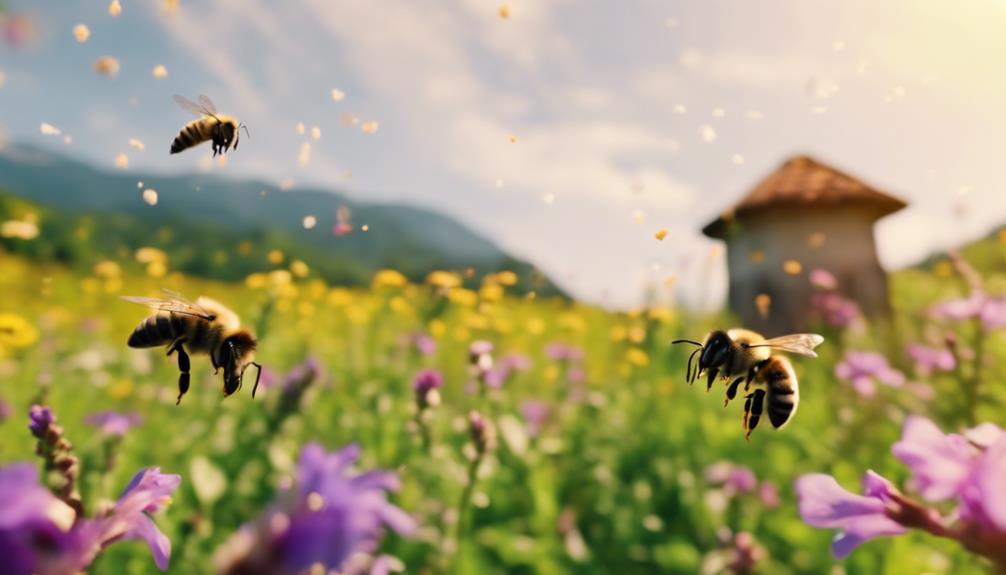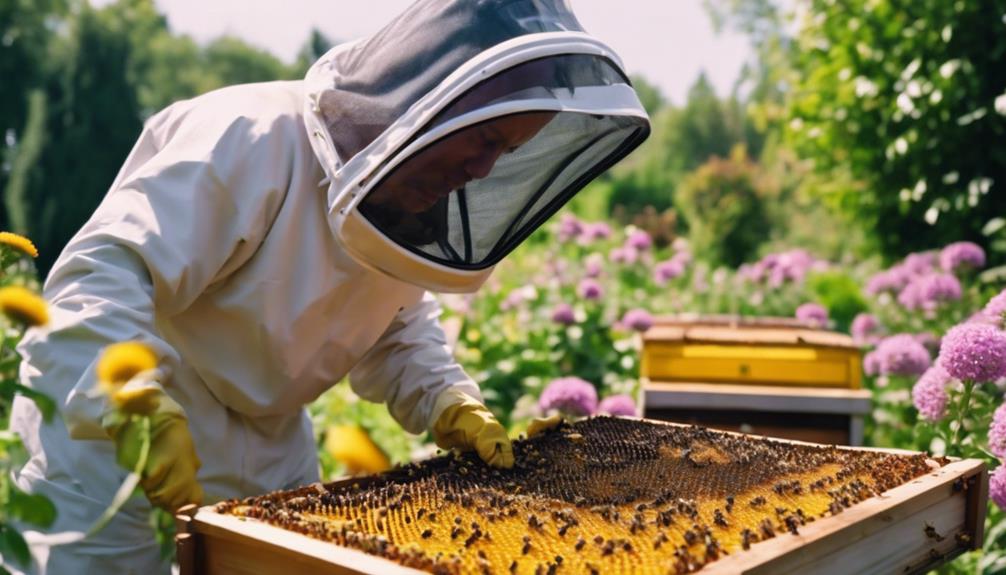When pondering between Italian or Carniolan bees, it’s crucial to contemplate what suits your beekeeping style and local climate best. Italian bees feature a lighter color and a gentle demeanor, ideal for beginners and those aiming for consistent honey production throughout the season. Conversely, Carniolan bees excel in colder climates, demonstrating resilience and adaptability to harsh weather conditions. Their robust winter populations and early foraging habits make them an excellent choice for beekeepers in chillier regions. Delve deeper into their specific traits to make the perfect selection for your buzzing companions.
Main Points
- Consider climate: Carniolan bees for cold regions, Italian bees for milder climates.
- Evaluate hive management: Carniolan bees need more attention, Italian bees are easier for beginners.
- Assess disease resistance: Carniolan bees have varroa tolerance, Italian bees may require more care.
- Prioritize honey production: Italian bees excel in high yields, Carniolan bees are efficient in storage.
- Factor in temperament: Italian bees are gentle, Carniolan bees are moderate, choose based on handling preference.
Characteristics of Italian Bees
Lighter in color and known for their mild temperament, Italian bees are highly favored by beekeepers for their ease of handling and reliable honey production levels. Their gentle nature makes working with them a breeze, creating a more enjoyable beekeeping experience.
Italian bees also stand out for their early brood production, giving them a head start on colony growth in the spring. This characteristic can be advantageous for beekeepers looking to build strong and thriving hives quickly.
However, it’s crucial to note that Italian bees have smaller populations going into winter, requiring extra attention and care to guarantee their survival through the colder months. Despite this, their consistent honey production levels make them a popular choice for many beekeepers seeking a reliable bee species for their apiaries.
Advantages of Italian Bees
Italian bees offer a range of benefits to beekeepers, making them a top choice for many apiaries. Known for their high honey production, these bees are like the busy workers in a bustling city, always bringing in the sweet nectar.
Their gentle temperament is akin to having a friendly neighbor who never fails to lend a helping hand. This makes working with Italian bees a delightful experience, reducing the chances of stings and making hive inspections a breeze.
Additionally, their better winter survival rates give beekeepers peace of mind during the colder months. For new beekeepers, Italian bees are a fantastic starting point due to their ease of management, setting them up for a successful beekeeping journey.
Considerations for Italian Bees
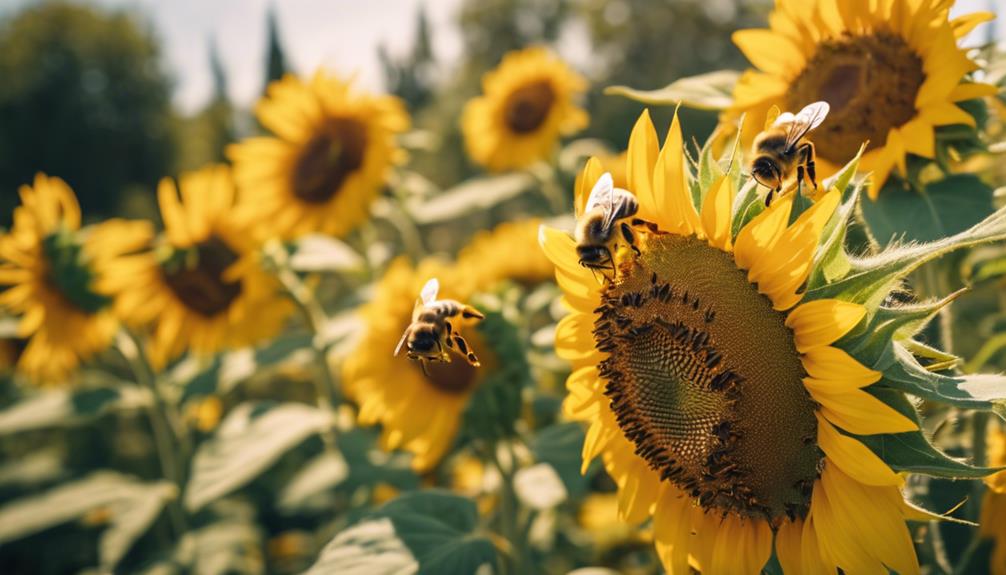
When considering Italian bees for your apiary, it’s important to take into account their tendencies for higher honey production and increased likelihood of brooding during winter. Italian bees are like the industrious bees of the neighborhood, always working diligently to fill their hives with that golden goodness. Their high honey production can be a sweet advantage for beekeepers looking to stock up on that liquid gold.
Plus, their gentle temperament makes them a joy to work with, like having little buzzing friends around. Just remember, these Italian bees might get a bit feisty in regards to robbing other hives, so keep an eye out for any neighborhood disagreements. Overall, Italian bees bring a lot to the table in terms of productivity and ease of handling.
Characteristics of Carniolan Bees
Acclimated to colder climates, Carniolan bees are renowned for their adaptability and productivity, making them a valuable addition to beekeeping operations in regions like the Pacific Northwest. These bees boast a robust winter population, ensuring the hive’s survival during harsh weather conditions.
Their prowess in honey production is impressive, with Carniolan bees known for higher honey yields and efficient honey storage. While they may have a slower start in brood production come spring, their queens make up for it by displaying remarkable capabilities in producing brood.
This blend of qualities makes Carniolan bees a sought-after choice for beekeepers looking to boost their hives’ resilience and productivity, especially in regions with cooler climates.
Advantages of Carniolan Bees

With their moderate temperament and early spring foraging habits, Carniolan bees offer beekeepers distinct advantages in hive management and honey production. These bees are like the cool, collected individuals in a bustling crowd, adapting smoothly to changes and starting their nectar-gathering mission earlier than their Italian counterparts.
Sure, they might have a tendency to swarm more, but with the right beekeeping techniques, that can be kept under control. Carniolan bees are the adaptable superheroes of the bee world, thriving even in colder climates like central Wisconsin by regulating their population during scarcity periods.
They’re the ones who get the party started early and keep it going strong. So, if you’re looking for bees with a knack for survival and productivity, Carniolans might just be your perfect match.
Considerations for Carniolan Bees
Considering the unique traits and behaviors of Carniolan bees, beekeepers should take into account specific factors when managing these bees in their hives.
- Hive Management: Carniolan bees require careful hive management due to their tendency to swarm more than Italian bees.
- Prone to Swarming: Beekeepers need to be proactive in preventing swarming by providing enough space and managing colony population.
- Winter Months: During the winter months, it’s important to make sure Carniolan bees have enough food reserves to survive the cold.
- Efficiency in Honey Processing: While Carniolan bees may not process honey as efficiently as Italian bees, their ability to thrive in colder climates like central Wisconsin makes them a suitable choice for beekeepers in such regions.
Italian Vs. Carniolan Bee Behavior
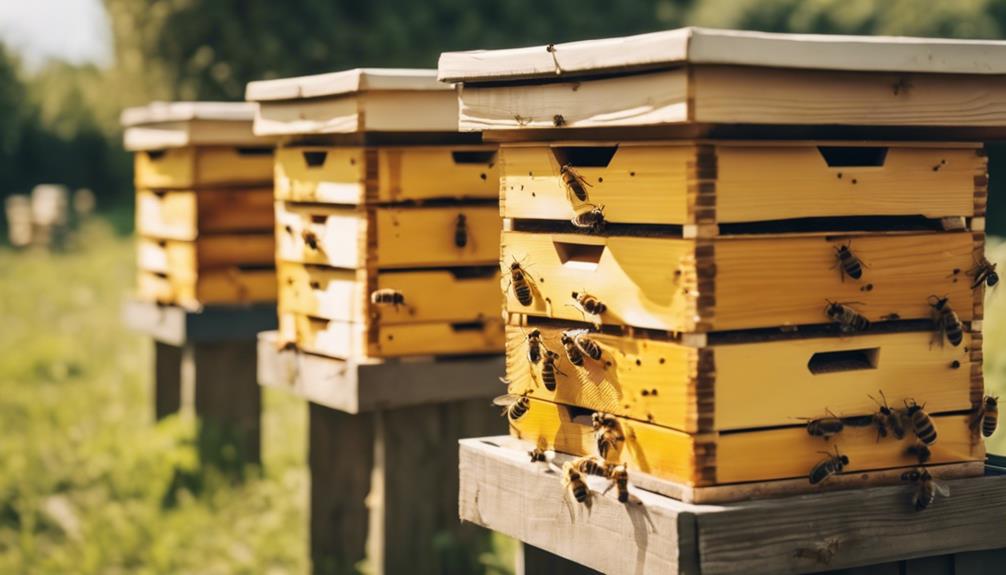
Comparing the behavior of Italian and Carniolan bees reveals distinct characteristics that influence their interactions within the hive and with the surrounding environment. Italian bees are known for their gentleness, hard work, and prolific breeding behavior. On the other hand, Carniolan bees have moderate strength colonies and adapt well to changes in their environment.
Italian bees may be more prone to pests due to their calm nature, while Carniolan bees are less likely to be provoked and exhibit a more critical behavior. It’s fascinating how individual experiences and hive characteristics can shape perceptions of Italian and Carniolan bee behavior.
Understanding these differences is important when deciding which bee species aligns best with your beekeeping goals and environment.
Climate Suitability for Each Bee Species
Carniolan bees, acclimated to colder climates, are best suited for regions with harsh winters like the Pacific Northwest. Here’s why they’re a good match for such climates:
- Winter Resilience: Carniolan bees boast larger winter populations, providing them with better chances of survival in colder temperatures.
- Climate Adaptability: Their ability to thrive in harsh conditions makes them ideal for areas with long, cold winters.
- Efficiency: Due to their adaptation to colder climates, Carniolan bees require less intervention and maintenance during winter months.
- Survival Rates: Their natural resilience to cold weather boosts their survival rates, ensuring a stable colony through the winter season.
Considering these factors, Carniolan bees could be the perfect choice for beekeepers in regions with demanding winter climates.
Varroa Tolerance and Disease Resistance
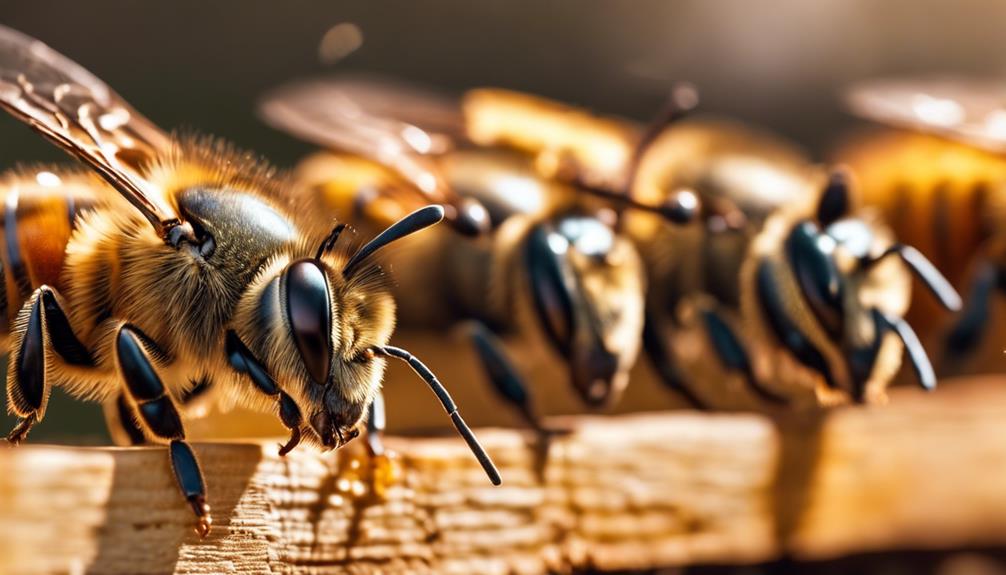
Known for their varroa tolerance and resistance to diseases, Carniolan bees have genetic traits that make them more resilient compared to Italian bees. This means less intervention and worry on our part as beekeepers, allowing us to focus on other aspects of beekeeping.
Carniolan bees possess a natural ability to combat varroa mites and common bee diseases, reducing the need for extensive management. On the other hand, Italian bees may require more attention and care to keep these issues at bay.
Making the Best Choice: Italian or Carniolan Bees
When choosing between Italian or Carniolan bees, it’s crucial to take into account their distinct characteristics, adaptability in different hive environments, and behavioral tendencies.
Italian bees are recognized for their high honey production and gentle nature, making them a popular choice for beekeepers seeking productivity and docile behavior.
On the flip side, Carniolan bees excel in colder climates, demonstrate frugality in food consumption, and possess varroa tolerance, factors that might influence beekeepers looking for resilience and efficiency in resource utilization.
Bee Characteristics Comparison
Comparing the characteristics of Italian and Carniolan bees can assist beekeepers in selecting the most suitable option for their specific needs and environment.
- Italian bees:
- Known for high honey production and gentleness.
- More aggressive in robbing other hives.
- Prolific egg layers with a higher likelihood of brooding during winter.
- Require more food, especially in winter.
- Carniolan bees:
- Valued for gentle nature and early foraging behavior.
- Tend to swarm more but have varroa tolerance.
- Well-suited for cold climates.
- Frugal in food consumption and regulate populations during dearth periods.
Choosing between Italian and Carniolan bees depends on factors like climate, desired honey production, and management preferences.
Hive Adaptability Factors
For beekeepers seeking ideal hive adaptability, understanding the distinctive features of Italian and Carniolan bees is essential. Italian bees are known for high honey production, which may require more food and have a higher likelihood of brooding in winter, making them less frugal. On the other hand, Carniolan bees are frugal, surviving well on minimal food, which is great for cold climates. Carniolans have a strong varroa tolerance, and though they swarm more, they’re gentler to work with.
When considering hive adaptability, factor in the brood nest size, varroa tolerance, and climate requirements. Italian bees might be easier to manage, but Carniolans can thrive with less maintenance in the right conditions.
Behavioral Traits Analysis
In beekeeping, understanding the behavioral traits of Italian and Carniolan bees is essential for making the best choice. Here are some key points to take into account:
- Italian bees are known for their gentle nature and high honey production, but they can be more aggressive in robbing other hives.
- Carniolan bees exhibit a gentle demeanor and are quick at creating comb, yet they’ve a higher tendency to swarm compared to Italian bees.
- Italian bees may require more food, especially in winter, while Carniolan bees are more frugal in their food consumption.
- In terms of swarming, Carniolan bees are more predisposed to this behavior, whereas Italian bees are recognized for their prolific egg laying and high brood production rates.

Hello! My name is Noel Calvin. I graduated from UCLA and now work as a writer at Launch Ninjas. I write blog posts that inspire and guide our readers in their entrepreneurial pursuits. I live in Pleasantville, NJ, with a peaceful yet lively atmosphere that inspires me.
Writing stories is more than just a job for me. It allows me to share my observations and satisfy my curiosity about the world. I combine my analytical skills with creative enthusiasm to delve into technology trends and startup stories. But my life isn’t limited to screens and keyboards. I value loyalty, passion, and a touch of old-fashioned charm, which I infuse into every narrative I create.
I love spending time in my garage, jamming with my band when I’m not writing. Playing the guitar and singing bring me immense joy. I also enjoy capturing ordinary and extraordinary moments through my camera lens and exploring new culinary adventures that excite my taste buds. I’m always seeking new experiences.
My family is very important to me. Joyful Sunday brunches filled with laughter and intense board game nights keep me grounded, reminding me of life’s simple pleasures.
In my world, every moment is an opportunity for discovery. Every discovery is a story worth sharing, whether a heartfelt moment at home or the pulse of technological innovations. Join me as I navigate through life, one blog post, one guitar strum, and one heartwarming family dinner at a time.
